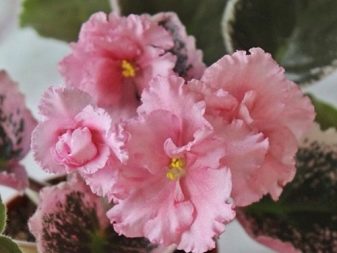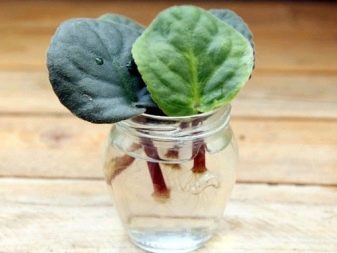Violet LE-Odalisque: description and agricultural technology

The Uzambara violet LE-Odalisque belongs to the Saintpaulia. In a botanical sense, it has nothing to do with ordinary violets, but this familiar name has taken root among flower growers. LE-Odalisque is a very beautiful flower, beloved by all fans of green "pets". Let us dwell in more detail on the description of this variety and the features of caring for it.

Description of the variety
LE-Odalisque is a breeding product of the famous Ukrainian scientist Elena Lebetskaya. Absolutely all of her brainchildren are very popular, not only in the CIS countries, but also far beyond their borders. It was she who created the world's only Lyon's Early Spring variety, a distinctive feature of which is huge snow-white flowers. Her violets have repeatedly received prizes at various exhibitions and competitions.
LE-Odalisque is a Saintpaulia with flowers of a pale pink hue. The central part of the bud is distinguished by a more intense color and looks like a dark eye, which attracts the eye to the depth of the flower, thereby giving it a special charm. As the plant matures, its color changes: it becomes darker, almost coral.


The blossoming flowers are rather large (as a rule, not less than 6-7 cm in diameter). The petals are neat, have the same size, wavy shape with smooth transitions. The edges are openwork, fringed. This gives the flower a special splendor and decorative effect. The flower shape with wide-open petals is called "star".
Peduncles are long and strong, due to which the flower rises above the leafy rosettes, as if crowning them. The rosette itself is quite neat, even, and round in shape. The size is 25-35 cm. The petioles are shortened and thickened, so the rosette seems to be dense. The leaf plates are saturated, dark green, heart-shaped, slightly curved upwards. Light yellow edging trims the edges. The marks chaotically located on the sheet plates have the same shade.


Care
LE-Odalisque is a very showy plant with velvety leaves and large, delicate inflorescences. These violets have won the love of flower growers not only for their decorativeness, but also for their exceptional unpretentiousness. Nevertheless, if you want your green "pet" to delight you with its flowering as long as possible, you should adhere to certain rules of caring for it.


Lighting
Like any other Saintpaulia, LE-Odalisque prefers diffused lighting. Therefore, it is better to install the flower on a windowsill located on the east or west side. Another good option is to put the flower on a table near the window. This plant categorically does not tolerate direct sunlight, so if you intend to place a violet on the south or southeast window, then it should be slightly shaded.b. Most often, for this purpose, a reflective film is glued or the glass is covered with thin paper.
From time to time, the violet pot must be rotated around its axis. If this is not done, then the sheet plates will stretch in only one direction, which will significantly worsen the appearance of the outlet.
The flower requires long daylight hours. If you do not provide Saintpaulia with the required amount of light, the plant will produce very few flowers or stop producing flower stalks altogether.... For full growth and flowering, it needs illumination for 12-14 hours, therefore, in winter, it needs additional illumination with special fluorescent or LED lamps.
Experienced growers prefer the second option, since LED lamps are more economical. In addition, they do not overheat the air around the plant.


Temperature
Saintpaulias prefer a moderate heat background. The optimum temperature for a flower is 20-23 degrees... At low or, conversely, higher temperatures, the plant stops blooming altogether.
It should be noted that LE-Odalisque does not tolerate cold. From low temperatures, the roots begin to rot, as the plant does not receive enough nutrients. To prevent the death of the flower in the winter, you need to put a foam plate under the pot.... It will protect the soil and, accordingly, the roots from freezing during the cold period.
At the same time, excessively high temperatures are also detrimental to Saintpaulia, so the container with a flower should be kept away from radiators and other heating devices.


Watering
Saintpaulias need regular but moderate watering. It is produced as the soil dries up about 2-3 times every 7 days.... It is best to pour water into a sump. The moisture remaining in the saucer should be drained after 15-20 minutes, otherwise the roots will begin to rot. For external irrigation, it is worth using a watering can with a long, thin spout so that the liquid falls strictly under the root, without affecting the velvet leaves and the growth point.


Air humidity
Saintpaulias prefer well humidified air, but leaves should not be sprayed. The best option is to turn on a humidifier for several hours a day or spray the space at a distance of 1-1.5 meters from the flower from a spray bottle.
It is not superfluous to put a container with a flower on a special tray with drainage and wet sphagnum.


Fertilizer
Once or twice a month from February to October, the plant needs fertilizing. To do this, it is best to use ready-made store-bought complex preparations created specifically for Saintpaulias.

Transplant and reproduction
Adult Saintpaulias should be replanted every spring. However, if you additionally highlight the flower with phytolamps, then you can transplant at any other time of the year.
Keep in mind that the transplant container should be small. The planting level is also of great importance - the growing point should correspond to the level of the soil, and the lower leaves should be located just above the substrate. If the plant is planted too high, its growth and development will be slowed down.
With excessive deepening, the growth point begins to rot, which inevitably leads to the death of the violet.

Violets are propagated by vegetative methods: seeds or cuttings. The seed method is very long and troublesome, therefore, as a rule, only breeders use it to create new varieties. At home, it is better to use cuttings. For this, a sheet is cut off with a sharp knife at a distance of 2.5-3.5 cm from the sheet plate. After that, the cuttings are placed in a vessel with water and placed in a bright, warm place.
Before the roots appear, you need to create conditions close to those of a greenhouse. To do this, cover the container with a plastic cup or plastic bag. As a rule, after 2-3 weeks, you can already see the first roots. After that, the cutting is very carefully transplanted into the soil mixture (it can be purchased at any specialized store). The planted sprouts need solid support, so they are additionally propped up with small sticks. As soon as a young growth of about 4-5 cm in length is formed, you can cut off the mother leaf - your violet has taken root and started growing.


You will learn how to transplant an adult violet from the video below.































The comment was sent successfully.